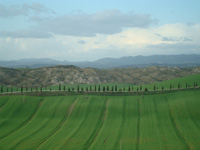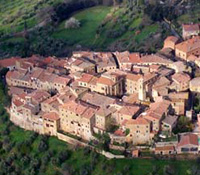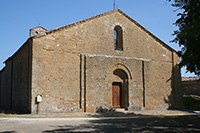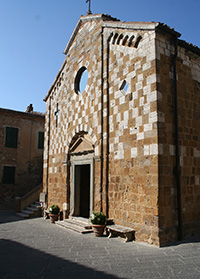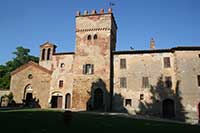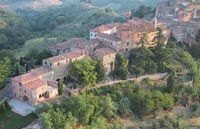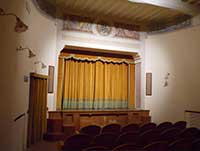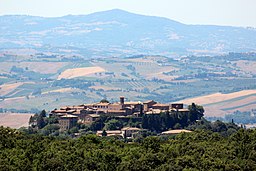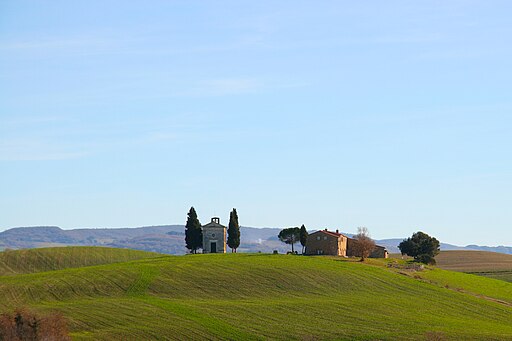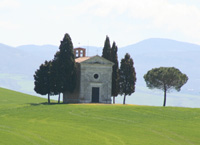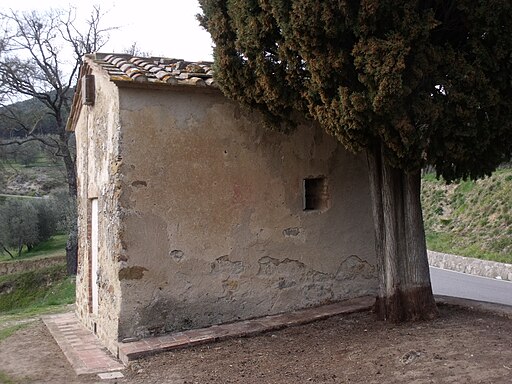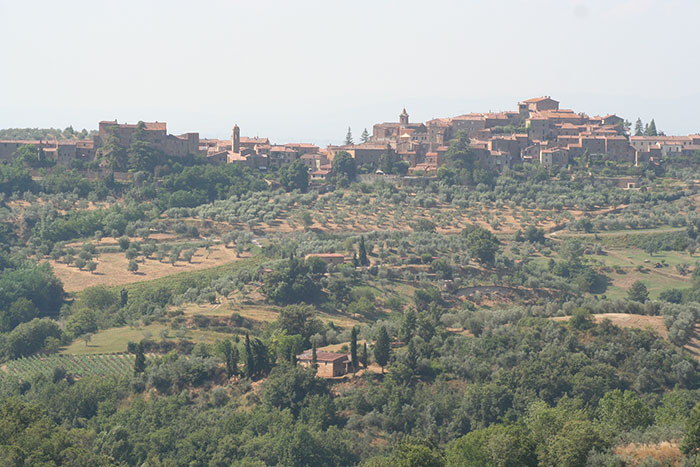 |
|
| N L
|
Montisi, seen from the Pieve di Santo Stefano in Cennano |
Castelmuzio |
Castelmuzio, an ancient village dating back to the time of the Etruscans, is built on a volcanic limestone hilltop overlooking an amazing landscape. Castelmuzio is located close to the heart of the UNESCO World Heritage Site, the Val d'Orcia Artistic, Natural and Cultural Park. These coveted designations are protecting this area’s cultural and artistic heritage and its miracle of nature called the crete senesi, a countryside characterized by undulating ploughed hills and densely forested woods. Castelmuzio is a mesmerizing medieval hamlet and precious treasure of the real Tuscany, and has been wonderfully preserved–you can touch the medieval walls, see the watch tower, and enter the village through the ancient arched stone gate. The cloister Sant Anna in Camprena and the old church Pieve de Santo Stefano in Cennano are situated on opposite sides of the village. The pieve di Santo Stefano a Cennano |
||
| The village includes three churches. The most famous is the Pieve di Santo Stefano in Cennano, just outside the village of Castelmuzio. This small parish church has a documented history since 715 A.D. Its location was originally an Etruscan place of worship, and much later the church was built over an early Roman temple. The part you see today was built in 1285 A.D. From the original base, divided into a nave and two aisles, all that remains are three apses, while today the interior is one single nave. In recent years a cemetery and Roman bath have been discovered very close to the church. During the 15th century the Confraternità della Santissima Trinità opened a hostel for pilgrims. These pilgrims came from France and other parts of Europe, usually on foot, to see the pope in Rome, and followed a route called the Via Francigena. Do visit the Sacred Art Museum which is housed inside. Pievi in Toscany | The pieve di Santo Stefano a Cennano
|
|
|
 |
||
Pieve di Santo Stefano a Cennano, absis
|
||
| Petroio |
||
| Petroio (13th century) is built on a curious circular plan and is one of the best brick castles in the region. The picturesque cone-like village perched on a hill, which spirals around a single narrow road within the remains of the ancient walls, the old houses, palaces and churches and the steps that lead up to the summit of the lower and the fort, preserves the warm blonde colour of the sandstone with which almost all of it is built. Its origins are etruscan as the name testifies, deriving from the etruscan Petruni, (or even from the Latin Praetorium, and archaeological remains discovered nearby. |
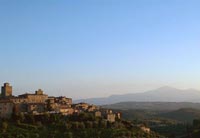 Petroio |
|
| Trequanda |
||
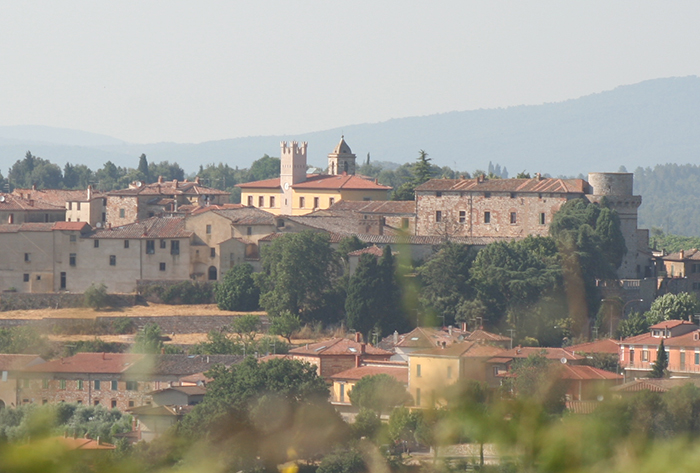 |
||
|
||
The medieval village of Trequanda, crowned by the remnants of the ancient Cacciaconti castle, is situated between the Val di Chiana and the Val d' Asso. The former medieval village still has visible remnants of its outer walls and two of the original three entrance portals. It stands on the top of a hill in a well maintained natural environment of woods, tidy fields of vines, olives and cereal crops. A third of the village is taken up by the castle Cacciaconti and its various annexes including a small ornamental garden. The majestic stone tower, partly rebuilt after the war, dominates the entire complex from the north-east and is a singular witness to the original fortified castle structure.
|
|
|
| Badia di Santa Maria in Sicille |
||
| A few kilometres to the northeast of Trequanda is the Abbadia a Sicille, a beautiful Italian old village. The history of the village dates back to approx 1.200 AD. Abbadia Sicille and Abbadia a Cignano, ancient Templar rest stops on the way to Rome. The name derives from the Etruscan name Segnes, and through the Latin Secennius became Sicille. The presence of the two crosses of Malta to the sides of the portal of the Chiesa di Santa Maria a Sicille suggests the foundation of the complex by the Knights of Malta. Pro Loco Trequanda | Badia di S. Maria a Sicille |
||
| Montisi, a frazioni of San Giovanni d'Asso, is a small ridgetop village north of Castelmuzio, located on an Etruscan road that linked the Maremma coastline with the rich city of Arezzo. Montisi is perched on a crag and built around the castle that forms the nucleus of the village. The name is a modernization of Monti Isi, or the Mount of Isis, reflecting the fact that an 8th century B.C. temple of Isis was located a couple of kilometres from Montisi. As you walk around Montisi, you will note that like Siena, it is divided into quarters – the famous contrade. At the edge of the village is the fortified Grancia. The Piccola Accademia di Montisi, located in Montisi, has been founded to provide a center of inspiration for musicians worldwide who have an interest in the harpsichord, its repertoire and its history. Although there are small vineyards all around Montisi there is no definitive local wine. There are three kinds of local wines: red, made principally from the Sangiovese grape and recently awarded its own DOC under the name of Orcia, a local peasant wine which is made with a component of about 20 percent white grapes, and the vin santo, a dessert wine that can range from dry to sweet. [Strada del Vino Orcia] Grancia is a fortified farm complex dating from the 14th century, built on the edge of Montisi, around a courtyard that stored provisions for the Spedale of Santa Maria della Scala in Siena. This extraordinary organisation took care of the flood of pilgrims to Rome that travelled the Via Francigena from the 12th century onwards, and was always in need of supplies. | ||
East of Trequanda you reach Sinalunga, a modern, thriving centre with connections to Siena, Arezzo and Chiusi. It has one notabIe painting, an anunciation by Benvenuto di Giovanni, in the church of San Francesco.
|
||
Holiday accomodation | Podere Santa Pia, hidden in the valley between Castiglioncello Bandini and Cinigiano |
|||
| Walking in Tuscany | From Castelmuzio to Pienza |
|||
| Solitary cypresses or lining in long rows ancient country roads, vineyeards which follow the ups and downs of rolling hills, streams overshadowed by trembling poplars, oaks and holm-oaks woods, strawberry trees and brooms growing on the banks of the roads, they make up the landscape which can be enjoyed on approaching Castelmuzio, the old, suggestive medieval village in the heart of Tuscany. Follow the road from Castelmuzio to Pienza which goes among beautiful country houses and sides the ancient Benedictine monastery of Sant'Anna in Camprena, a sacred place even at the time of Pope Pius II. Its enchanting refectory painted by the famous '400 century painter Sodoma is worth a visit. This suggestive site has also been the setting to the famous film The English Patient by Anthony Minghella. When you reach the SS146 to Pienza, you can follow the next walk (Walking around Pienza, marked blue) In both directions you finally reach Pienza. |
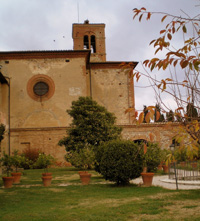 On a hill opposite the medieval fortress of Castelmuzio is the picturesque abbey of Santa Anna in Camprena |
||
| Walking around Pienza |
|||
The walk takes off at Piazza Dante Alighieri, through the Viale S. Caterina, direction Pieve di Corsignano. Map |
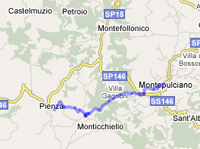 |
||
Montisi - Castelmuzio |
|||
Trekking in de Crete Senesi | Walk around Montisi and the ruins of Montelifé The itinerary is along old tracks, tarred in parts, otherwise gravel and grass.
|
 |
||
|
Panorama of Montisi from Via degli Ortali | ||
Maps: Multigraphic Val d'Orcia, Kompass nr. 662 Lago trasimeno and Kompass nr. 653 Pienza-Montalcino-Monte Amiata. Links
|
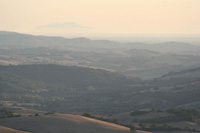 View from Podere Santa Pia |
||
|
|||

